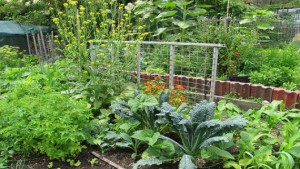For those who may be new to organic gardening, permaculture may be an unfamiliar term, or perhaps one that you’ve heard of but not read up on yet. Permaculture, in its broadest definition, is a type of ecological and environmental design that develops as a self-maintained agricultural system, modeled on natural ecosystems.
As author, scientist and teacher Bill Mollison famously remarked, Permaculture “is a philosophy of working with, rather than against, nature.” Truly, by gardening in a way that is in harmony with the planet, rather than fighting it, we can set ourselves up for years of sustainability and achieve productive results without hurting the Earth.
There are three core tenets of Permaculture,
and while each garden is different, these basic principles remain constant:
- Care for the earth. This involves taking provisions and planning in a way that allows all life systems to continue and multiply. Whether it’s to a larger extent, such as not destroying animal habitats for the sake of commercial agriculture, or on a smaller scale, such as not using pesticides in your backyard garden, care for the earth is the first principle. After all, without a healthy planet, even human beings can’t flourish!
- Care for the people. Ensure that, as a result of your agricultural endeavors, people are not denied access to resources necessary for their existence. This may often be a financial matter, such as paying agricultural workers fair wages for their time and products. However, it can also be defined as growing healthy, non-GMO produce that is genuinely good for those who eat it.
- Return of surplus. Returning surplus produce back into the system is a natural way of recycling plants and ensuring excess doesn’t go to waste. It provides quality, natural fertilizer for organic gardening and returns nutrients to the soil, making for increased sustainability.

As Permaculture is a design philosophy, twelve unique principles are behind setting up an organic gardening project in this manner.
There are also, typically, certain patterns and layers used to ensure its effectiveness and sustainability.
The design principles commonly associated with permaculture initiatives, as set forth by ecological educator and environmental designer David Holmgren include:
- Observing and interacting, to engage with nature and design solutions that suit their location.
- Catching and storing energy, to collect resources when they’re most abundant and use them in times of need.
- Obtaining yields, to get useful rewards for the work put in.
- Self-regulating and accepting feedback, to improve and grow as a sustainable gardener.
- Using and valuing renewable resources, consuming as little as possible and making the most of the Earth’s resources.
- Producing no waste, by valuing and using all resources available.
- Designing from patterns and details, by observing them in nature and society and making them the backbone of our ecological designs.
- Integrating rather than segregating, by putting things in strategic locations so they can work together.
- Using small, slow solutions, which are easier to maintain than big ones.
- Using and valuing diversity, reducing vulnerability to threats and taking advantage of nature’s resources.
- Using edges and margins, which can often be diverse, valuable and productive.
- Creatively using and responding to change, to observe carefully and make a positive impact.
If this all sounds a bit much, don’t fret – while permaculture and organic gardening require forethought and planning, they don’t have to be complicated. The patterns, layers and zones involved are easy to establish by following the examples of others who have done it in areas like yours.
A great way to get started is to do some reading and talk to others, online or in person, who engage in sustainable gardening projects. Once you have an idea of what you’d like to grow, you can literally draw out your garden on paper and then transfer that outline to your yard.
Thankfully, there an abundance of resources online that will help you get started, as well as support you once you’re established. With a little planning, your garden will be an excellent source of produce for you and your family, and will sustain itself for years to come, acting as a benefit to the Earth instead of a strain on it.


Leave a Reply